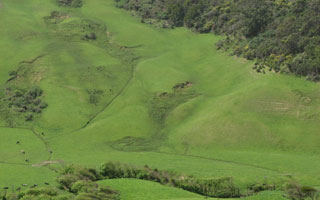Land slip
|
What is it? |  A complex of landslips in Otway dairy country |
Impact
Land slip often damages private and public assets as it inexorably moves down-hill. Buildings, tracks, roads, powerlines, and streams can be demolished or blocked.
Further, as a consequence of slippage, the remodel landscape, can restrict access, interrupt drainage systems and initiate further erosion
Management
Prevention of land slips in susceptible areas involves minimising changes to local hydrology such that water does not build up and accumulate within areas which may slip. This means avoiding the accumulation of via table drains, diversion drains or culvers. It means maximising evapotranspiration from all plants in the areas of susceptibility, both to reduce the build up of water, but also to maximize surface cover and root growth.
Reclamation is somewhat vexed but must involve the stabilisation of the area with both vegetation and some physical structures, and perhaps even some internal drainage of the slipped mass to prevent further movement.


